2016 SUBARU BRZ light
[x] Cancel search: lightPage 33 of 490

32 1-2. Opening, closing and locking the doors and trunk lid
■Notes for locking the doors
●Touching the door lock sensor while wearing gloves may delay or prevent
lock operation. Remove the gloves and touch the lock sensor again.
●When the lock operation is performed using the lock sensor, recognition
signals will be shown up to two consecutive times. After this, no recogni-
tion signals will be given.
●If the door handle becomes wet when washing the vehicle while the
access key is within the effective range, the door may lock and unlock
repeatedly. In this case, place the access key in a location 6 ft. (2 m) or
more away from the vehicle (take care to ensure that the key is not sto-
len), and continue to wash the vehicle.
●If the access key is inside the vehicle and a door handle becomes wet
during a car wash, a buzzer will sound outside the vehicle. To turn off the
alarm, lock all the doors.
●The lock sensor may not work properly if it comes into contact with ice,
snow, mud, etc. Clean the lock sensor and attempt to operate it again.
■Notes for the unlocking function
●A sudden approach to the effective range or door handle may prevent the
doors from being unlocked. In this case, return the door handle to the
original position and check that the doors unlock before pulling the door
handle again.
●Gripping the door handle when wearing a glove may not unlock the door.
Remove the gloves and touch the sensor on the back of the handle
again.
●If the door handle becomes wet when washing the vehicle while the
access key is within the effective range, the door may lock and unlock
repeatedly. In this case, place the access key in a location 6 ft. (2 m) or
more away from the vehicle (take care to ensure that the key is not sto-
len), and continue to wash the vehicle.
●If there is another access key in the detection area, it may take slightly
longer to unlock the doors after the door handle is gripped.
Page 39 of 490

38 1-2. Opening, closing and locking the doors and trunk lid
■Operation signals
Doors: A buzzer sounds and the hazard warning flashers flash to indicate
that the doors have been locked/unlocked. (Locked: once;
Unlocked: twice)
Trunk lid: A buzzer sounds to indicate that the trunk lid has been unlocked.
■Door lock buzzer (vehicles with a keyless access with push button
start system)
If an attempt to lock the doors is made when a door is not fully closed, a
buzzer sounds continuously. Fully close the door to stop the buzzer, and lock
the vehicle once more.
■Panic mode
Vehicles without a keyless access with push button start system
Vehicles with a keyless access with push button start systemWhen is pressed for longer than
about one second, an alarm will sound
intermittently and the vehicle lights will
flash to deter any person from trying to
break into or damage your vehicle.
To stop the alarm, press any button on
the transmitter.
When is pressed for longer than
about one second, an alarm will sound
intermittently and the vehicle lights will
flash to deter any person from trying to
break into or damage your vehicle.
To stop the alarm, press any button on
the access key.
Page 45 of 490
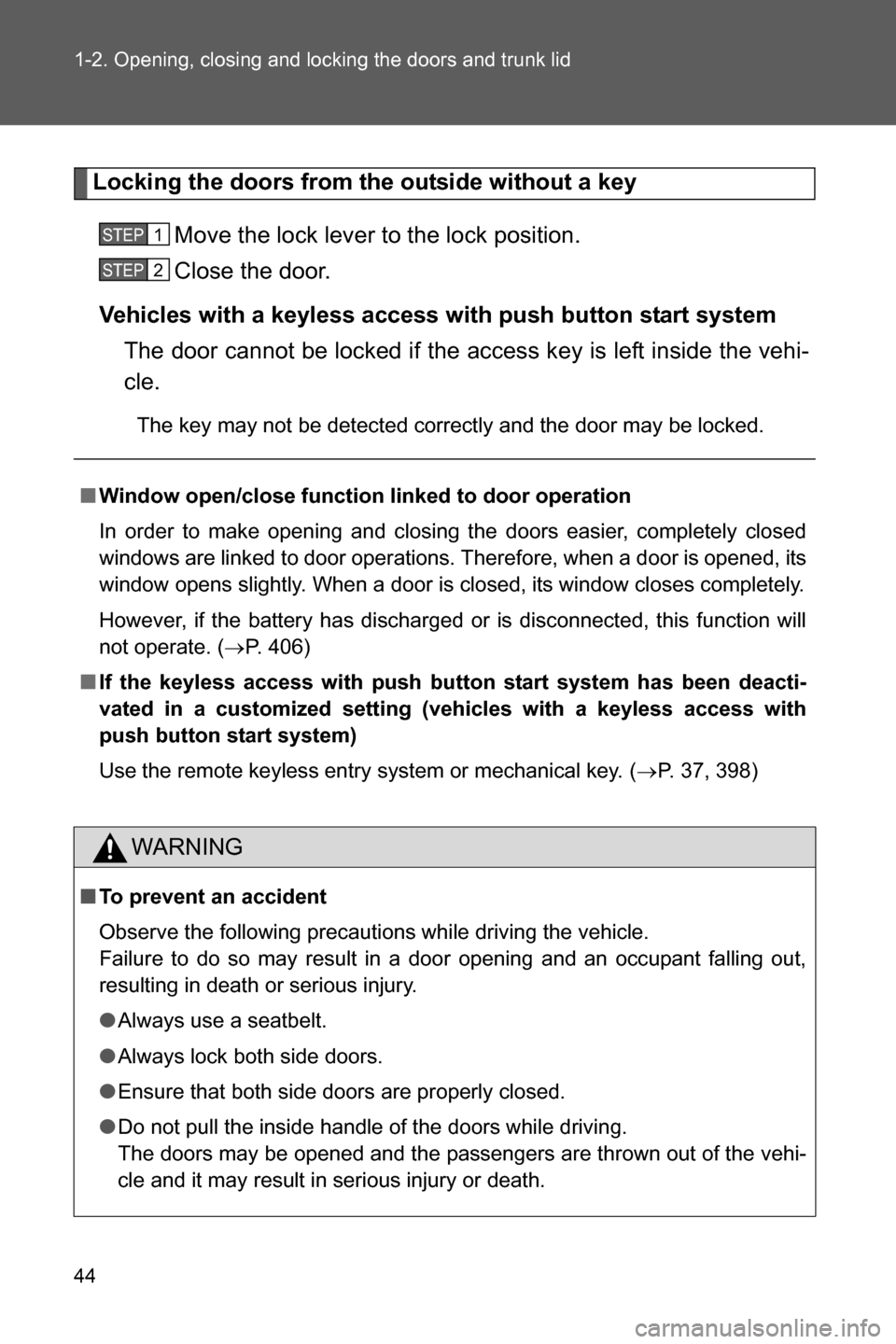
44 1-2. Opening, closing and locking the doors and trunk lid
Locking the doors from the outside without a key
Move the lock lever to the lock position.
Close the door.
Vehicles with a keyless access with push button start system
The door cannot be locked if the access key is left inside the vehi-
cle.
The key may not be detected correctly and the door may be locked.
■Window open/close function linked to door operation
In order to make opening and closing the doors easier, completely closed
windows are linked to door operations. Therefore, when a door is opened, its
window opens slightly. When a door is closed, its window closes completely.
However, if the battery has discharged or is disconnected, this function will
not operate. (�oP. 406)
■If the keyless access with push button start system has been deacti-
vated in a customized setting (vehicles with a keyless access with
push button start system)
Use the remote keyless entry system or mechanical key. (�oP. 37, 398)
WARNING
■To prevent an accident
Observe the following precautions while driving the vehicle.
Failure to do so may result in a door opening and an occupant falling out,
resulting in death or serious injury.
●Always use a seatbelt.
●Always lock both side doors.
●Ensure that both side doors are properly closed.
●Do not pull the inside handle of the doors while driving.
The doors may be opened and the passengers are thrown out of the vehi-
cle and it may result in serious injury or death.
STEP 1
STEP 2
Page 48 of 490
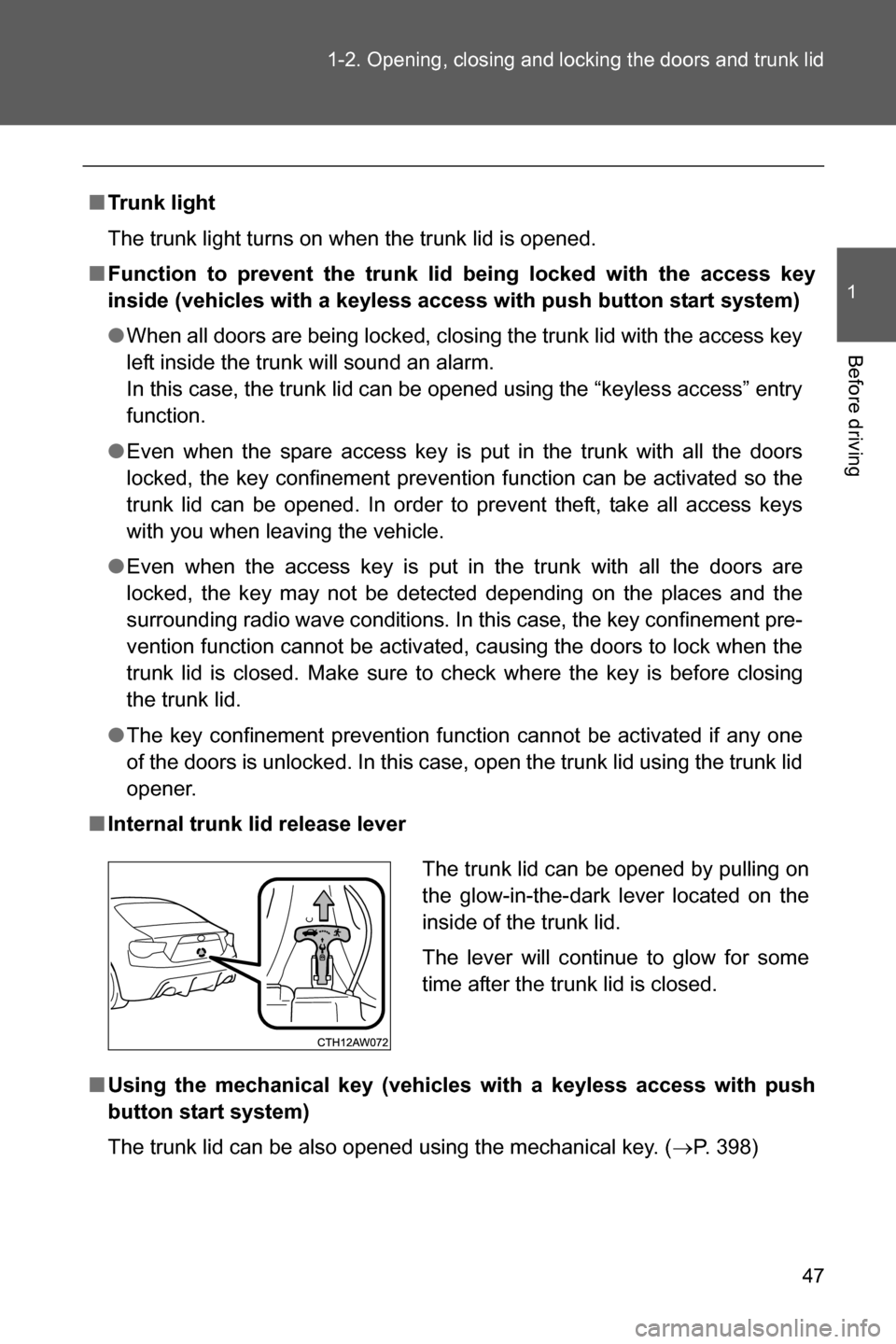
47 1-2. Opening, closing and locking the doors and trunk lid
1
Before driving
■Trunk light
The trunk light turns on when the trunk lid is opened.
■Function to prevent the trunk lid being locked with the access key
inside (vehicles with a keyless access with push button start system)
●When all doors are being locked, closing the trunk lid with the access key
left inside the trunk will sound an alarm.
In this case, the trunk lid can be opened using the “keyless access” entry
function.
●Even when the spare access key is put in the trunk with all the doors
locked, the key confinement prevention function can be activated so the
trunk lid can be opened. In order to prevent theft, take all access keys
with you when leaving the vehicle.
●Even when the access key is put in the trunk with all the doors are
locked, the key may not be detected depending on the places and the
surrounding radio wave conditions. In this case, the key confinement pre-
vention function cannot be activated, causing the doors to lock when the
trunk lid is closed. Make sure to check where the key is before closing
the trunk lid.
●The key confinement prevention function cannot be activated if any one
of the doors is unlocked. In this case, open the trunk lid using the trunk lid
opener.
■Internal trunk lid release lever
■Using the mechanical key (vehicles with a keyless access with push
button start system)
The trunk lid can be also opened using the mechanical key. (�oP. 398) The trunk lid can be opened by pulling on
the glow-in-the-dark lever located on the
inside of the trunk lid.
The lever will continue to glow for some
time after the trunk lid is closed.
Page 50 of 490
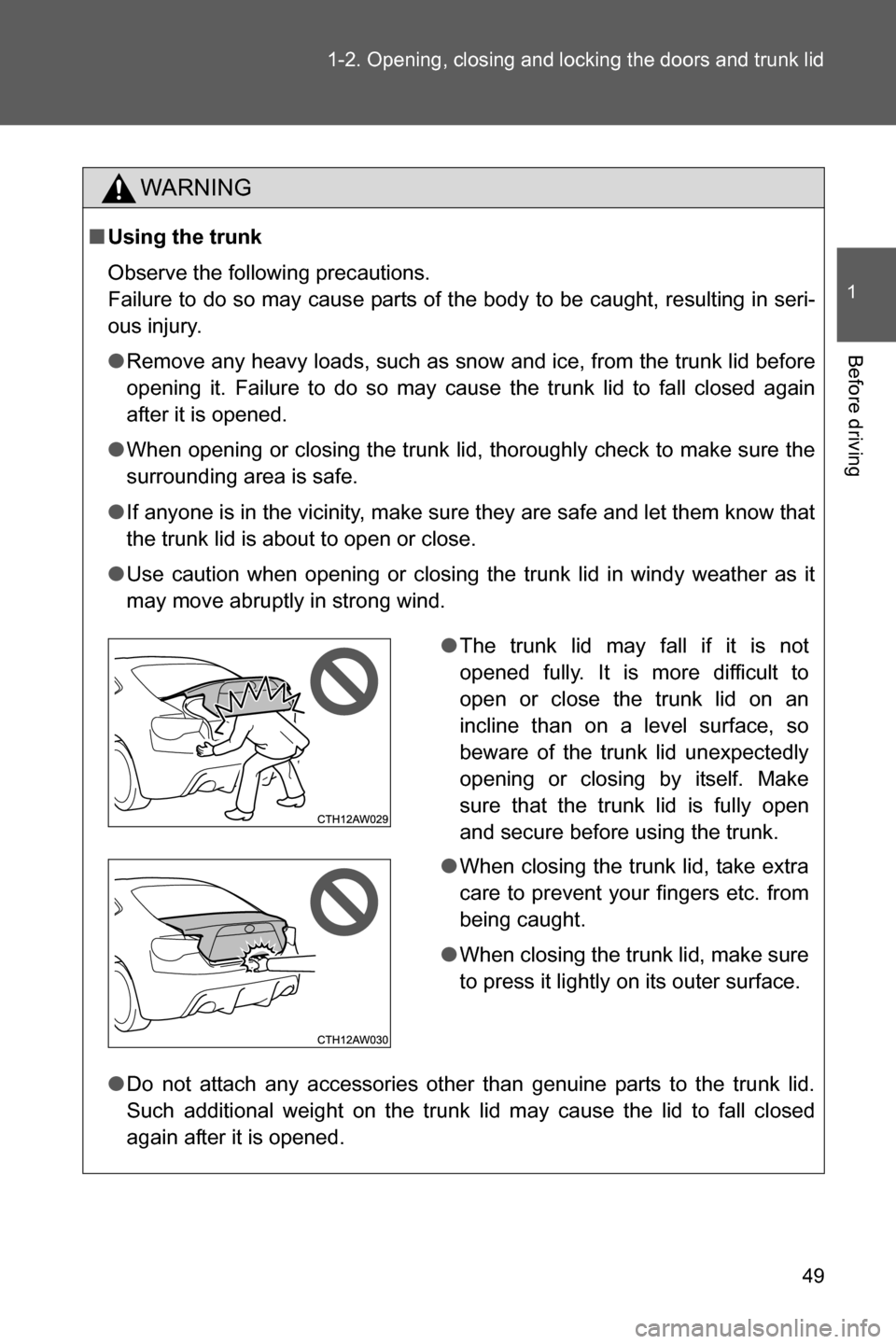
49 1-2. Opening, closing and locking the doors and trunk lid
1
Before driving
WARNING
■Using the trunk
Observe the following precautions.
Failure to do so may cause parts of the body to be caught, resulting in seri-
ous injury.
●Remove any heavy loads, such as snow and ice, from the trunk lid before
opening it. Failure to do so may cause the trunk lid to fall closed again
after it is opened.
●When opening or closing the trunk lid, thoroughly check to make sure the
surrounding area is safe.
●If anyone is in the vicinity, make sure they are safe and let them know that
the trunk lid is about to open or close.
●Use caution when opening or closing the trunk lid in windy weather as it
may move abruptly in strong wind.
●Do not attach any accessories other than genuine parts to the trunk lid.
Such additional weight on the trunk lid may cause the lid to fall closed
again after it is opened.
●The trunk lid may fall if it is not
opened fully. It is more difficult to
open or close the trunk lid on an
incline than on a level surface, so
beware of the trunk lid unexpectedly
opening or closing by itself. Make
sure that the trunk lid is fully open
and secure before using the trunk.
●When closing the trunk lid, take extra
care to prevent your fingers etc. from
being caught.
●When closing the trunk lid, make sure
to press it lightly on its outer surface.
Page 54 of 490
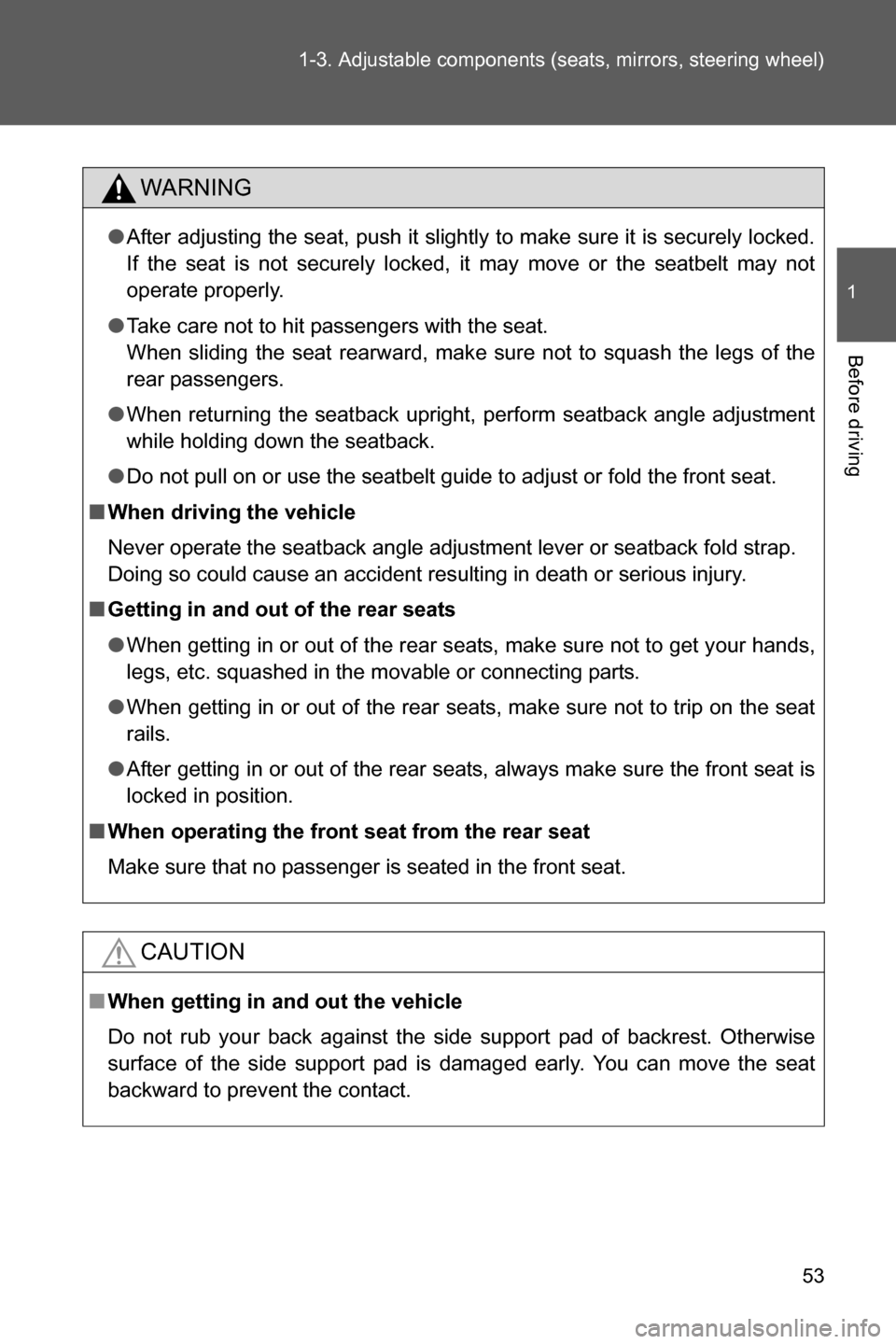
53 1-3. Adjustable components (seats, mirrors, steering wheel)
1
Before driving
WARNING
●After adjusting the seat, push it slightly to make sure it is securely locked.
If the seat is not securely locked, it may move or the seatbelt may not
operate properly.
●Take care not to hit passengers with the seat.
When sliding the seat rearward, make sure not to squash the legs of the
rear passengers.
●When returning the seatback upright, perform seatback angle adjustment
while holding down the seatback.
●Do not pull on or use the seatbelt guide to adjust or fold the front seat.
■When driving the vehicle
Never operate the seatback angle adjustment lever or seatback fold strap.
Doing so could cause an accident resulting in death or serious injury.
■Getting in and out of the rear seats
●When getting in or out of the rear seats, make sure not to get your hands,
legs, etc. squashed in the movable or connecting parts.
●When getting in or out of the rear seats, make sure not to trip on the seat
rails.
●After getting in or out of the rear seats, always make sure the front seat is
locked in position.
■When operating the front seat from the rear seat
Make sure that no passenger is seated in the front seat.
CAUTION
■When getting in and out the vehicle
Do not rub your back against the side support pad of backrest. Otherwise
surface of the side support pad is damaged early. You can move the seat
backward to prevent the contact.
Page 56 of 490
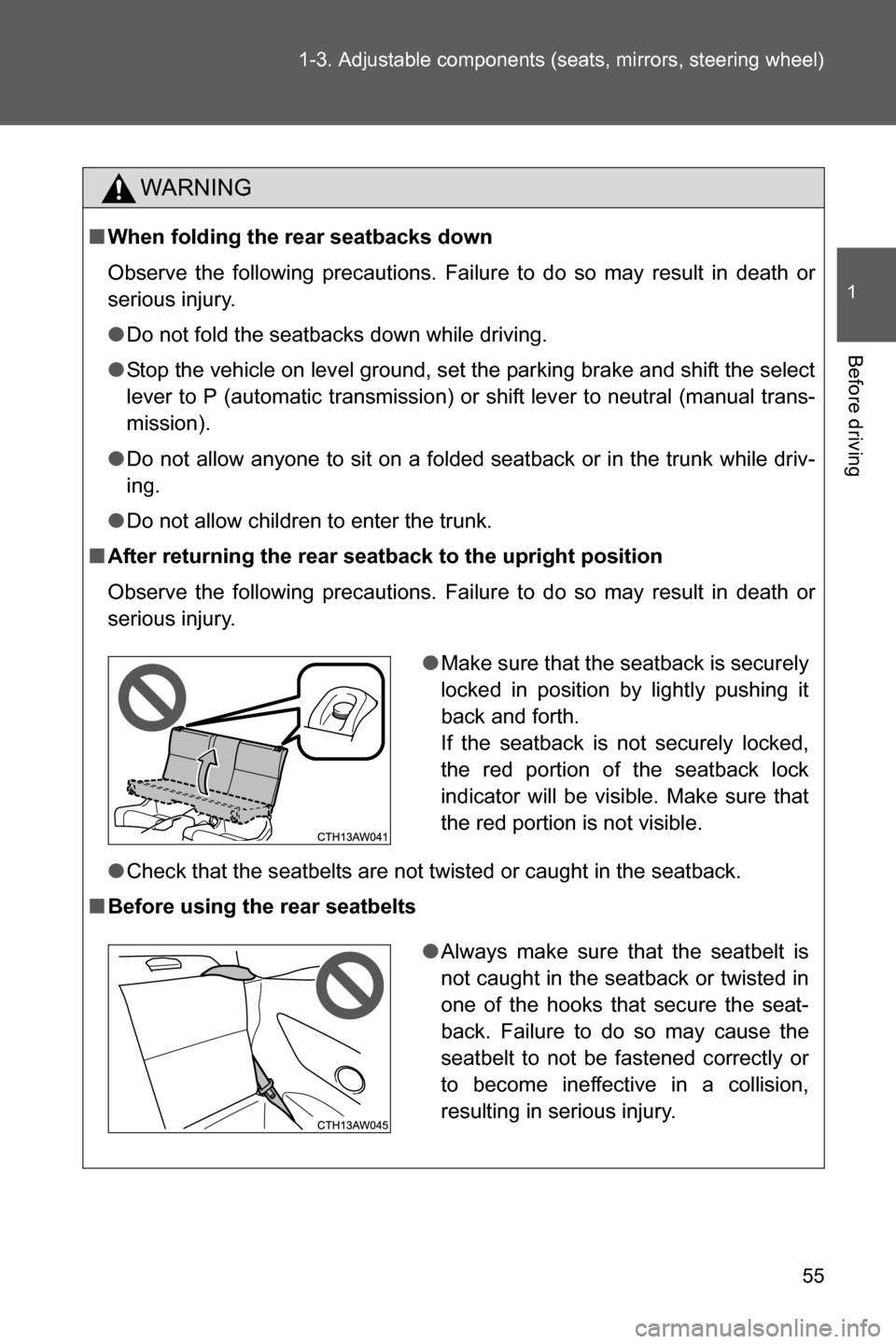
55 1-3. Adjustable components (seats, mirrors, steering wheel)
1
Before driving
WARNING
■When folding the rear seatbacks down
Observe the following precautions. Failure to do so may result in death or
serious injury.
●Do not fold the seatbacks down while driving.
●Stop the vehicle on level ground, set the parking brake and shift the select
lever to P (automatic transmission) or shift lever to neutral (manual trans-
mission).
●Do not allow anyone to sit on a folded seatback or in the trunk while driv-
ing.
●Do not allow children to enter the trunk.
■After returning the rear seatback to the upright position
Observe the following precautions. Failure to do so may result in death or
serious injury.
●Check that the seatbelts are not twisted or caught in the seatback.
■Before using the rear seatbelts
●Make sure that the seatback is securely
locked in position by lightly pushing it
back and forth.
If the seatback is not securely locked,
the red portion of the seatback lock
indicator will be visible. Make sure that
the red portion is not visible.
●Always make sure that the seatbelt is
not caught in the seatback or twisted in
one of the hooks that secure the seat-
back. Failure to do so may cause the
seatbelt to not be fastened correctly or
to become ineffective in a collision,
resulting in serious injury.
Page 61 of 490

60 1-3. Adjustable components (seats, mirrors, steering wheel)
■Emergency locking retractor (ELR)
The retractor will lock the belt during a sudden stop or on impact. It may also
lock if you lean forward too quickly. A slow, easy motion will allow the belt to
extend so that you can move around fully.
■Automatic locking retractor (ALR)
When a passenger's shoulder belt is completely extended and then
retracted even slightly, the belt is locked in that position and cannot be
extended. This feature is used to hold the child restraint system (CRS) firmly.
To free the belt again, fully retract the belt and then pull the belt out once
more. (�oP. 138)
■Child seatbelt usage
The seatbelts of your vehicle are principally designed for persons of adult
size.
●Use a child restraint system appropriate for the child, until the child
becomes large enough to properly wear the vehicle's seatbelt.
(�oP. 134)
●When the child becomes large enough to properly wear the vehicle's
seatbelt, follow the instructions on P. 58 regarding seatbelt usage.
■Seatbelt pretensioners
●Seatbelt pretensioners are not designed to activate in minor frontal or
side impact, in rear impacts or in roll-over accidents.
●The following four components operate simultaneously when the vehicle
is subjected to a severe frontal collision.
• Seatbelt pretensioner for driver
• Seatbelt pretensioner for front passenger
• SRS front airbag for driver
• SRS front airbag for front passenger*
*: This does not operate while the occupant detection system determines to
deactivate the airbag operation. For details, refer to “Front passenger’s
SRS frontal airbag” (�oP. 9 7 )
●The following two components operate simultaneously when the vehicle
is subjected to a severe collision on the driver’s seat side of the vehicle.
• Seatbelt pretensioner for driver
• Side airbag for driver